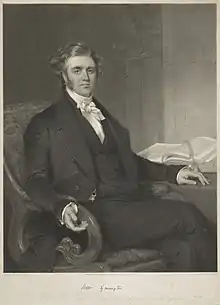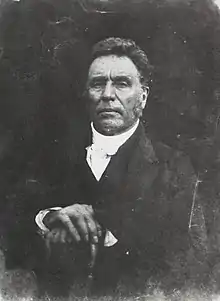William Symington (minister)
William Symington was a Presbyterian minister. He took a deep interest in bible circulation, home and foreign missions, and other religious movements.
William Symington | |
|---|---|
 from A Kirk and a College in the Craigs of Stirling[1] | |
| Church | Paisley |
| Personal details | |
| Born | 2 June 1795 |
| Died | 28 January 1862 |
| minister of Stranraer | |
| In office 18 August 1819 – 11 July 1839 | |
| minister of Great Hamilton Street | |
| In office 11 July 1839 – 28 January 1862 | |
| Professor of Systematic Theology to the Reformed Presbytery Synod | |
| In office 1853–1862 | |



Life
William Symington was born in Paisley on June 2, 1795, a brother of Andrew Symington. In his youth he attended a private school and Paisley Academy. In 1810 he took classes at Glasgow University and spent the sessions 1814–17 at the Hall at Stirling. He was licensed by the Western Presbytery on June 30, 1818. Two calls were presented to him at the Synod of 1819: Airdrie and Stranraer — and he accepted Stranraer. He was ordained on August 18, 1819.[2]
On a vacancy occurring in Great Hamilton Street, Glasgow he was elected on March 5 1839, although there was a considerable feeling in the Church against "transportations", and a minority was opposed to him on that account. He had already been twice chosen for West Campbell Street in the same city but the Synod had refused to present one call and he had declined the other.[2] He was inducted on 11 July 1839.
In 1839, he published his book, "Messiah, the Prince"; was created D.D. by the University of Edinburgh; and removed from Stranraer to Glasgow. From that time to 1862 Great Hamilton Street Church had a Christian orator for its minister. Symington was a friend of Thomas Chalmers. The proposal in the Senatus of Edinburgh University to confer the degree of D.D. on Symington was proposed by him, and seconded by David Welsh. When the Disruption came Symington sympathised largely with the movement and walked in the historical procession from St. Andrew's Church to Cannonmills. When people wondered why Symington did not then join the Free Church, he said, "With a great sum they purchased their freedom, but I was free-born."[1]
Symington's ministry in Glasgow resulted in an increase in the membership of the congregation, which reached nearly 1000. One of his missionaries in Glasgow was John G. Paton, D.D., afterwards of New Hebrides. On the death of his brother in 1853 he was elected to the Chair of Systematic Theology. In 1855 he was under the necessity of applying for a colleague, but it was not till March 3, 1859, that his son, William, was settled over the congregation. He died on January 28, 1862, and was buried in the necropolis of Glasgow.[3][2]
Family
In 1820 he married Anne Spiers. Two sons entered the ministry — William and Alexander — and a daughter became the wife of William Henry Goold of Edinburgh. [2] He married 27 June 1820, Agnes, daughter of Robert Spiers, farmer, Renfrewshire, and had issue -
- Margaret Spiers (married W. H, Goold, Reformed Presbyterian Church, Edinburgh)
- William, Reformed Presbyterian Church Glasgow
- Robert, born 22 August, 1825 died as a result of an accident in the manse garden, died, 31 August 1833
- Marion (married Matthew Clark, Glasgow)
- Andrew, Glasgow, (married Felicia Colquhoun)
- Alex. Macleod, Reformed Presbyterian Church, Dumfries
- Agnes Anne (married William McCormick, Dumfries)[4]
Publications
His contributions to literature included a number of fugitive pieces which he published while in Stranraer, but his chief works are The Atonement and Intercession of Jesus Christ, Edin., 1834, and Messiah the Prince, Edin., 1839. He received the degree of D.D. from Edinburgh in 1839.[2] The 1881 edition of Messiah the Prince contains a biography of William Symington.[5]
References
Citations
Sources
- Anderson, William (1877). "Symington, Andrew". The Scottish nation: or, The surnames, families, literature, honours, and biographical history of the people of Scotland. Vol. 3. A. Fullarton & co. p. 548.
 This article incorporates text from this source, which is in the public domain.
This article incorporates text from this source, which is in the public domain.
- Charnock, Stephen; Symington, William (1853a). Discourses upon the existence and attributes of God. Vol. 1. New York: Robert Carter.
- Charnock, Stephen; Symington, William (1853b). Discourses upon the existence and attributes of God. Vol. 2. New York: Robert Carter.
- Couper, W. J. (1925). The Reformed Presbyterian Church in Scotland, its congregations, ministers and students. Scottish Church History Society. pp. 100-101.
 This article incorporates text from this source, which is in the public domain.
This article incorporates text from this source, which is in the public domain.
- Hutchison, Matthew (1893). The Reformed Presbyterian Church in Scotland; its origin and history 1680-1876. Paisley: J. and R. Parlane. pp. 269-308.
 This article incorporates text from this source, which is in the public domain.
This article incorporates text from this source, which is in the public domain.
- Irving, Joseph (1881). The book of Scotsmen eminent for achievements in arms and arts, church and state, law, legislation, and literature, commerce, science, travel, and philanthropy. Paisley: A. Gardner. p. 513.
 This article incorporates text from this source, which is in the public domain.
This article incorporates text from this source, which is in the public domain.
- Johnstone, Thomas Boston (1898). "Symington, William (1795-1862)". In Lee, Sidney (ed.). Dictionary of National Biography. Vol. 55. London: Smith, Elder & Co.
- Ormond, D D (1897). A Kirk and a College in the Craigs of Stirling. Stirling: At the Journal & Advertiser Office. pp. 74-77.
- Robb, James E. (2013w). Cameronian Fasti: Ministers and Missionaries of the Reformed Presbyterian Church of Scotland, 1680-1929. p. 31.
not dated, uploaded 2013
 This article incorporates text from this source, which is in the public domain.
This article incorporates text from this source, which is in the public domain. This article incorporates text from this source, which is in the public domain.
This article incorporates text from this source, which is in the public domain.
- Smith, John (1853). Our Scottish clergy : fifty-two sketches, biographical, theological, & critical, including clergymen of all denominations. Vol. 1. Edinburgh: Oliver & Boyd. pp. 78-84.
- Symington, Alexander Macleod. "Memoir of William Symington, by his son Alexander Macleod Symington, taken from the 1881 edition of Messiah the Prince". Stranraer Reformed Presbyterian Church.
- Symington, William (1832). "The Cause of the Scottish Martyrs". The American Christian expositor : designed to . Vol. 1. New York: H.C. Sleight. pp. 432-436.
- Symington, William (1843). Bicentenary of the Assembly of Divines at Westminster : held at Edinburgh, July 12th and 13th, 1843 ; containing a full and authentic report of the addresses and conversations. With introductory sermon. Edinburgh: W.P. Kennedy.
- Symington, William (1847). On the atonement and intercession of Jesus Christ. New York: Robert Carter.
- Symington, William (1847b). The choice works of the Rev. Stephen Charnock, B.D. : with his life and character. New York: R. Carter.
- Symington, William (1851). Discourses on public occasions. Glasgow: David Bryce.
- Symington, William (1853). Departed Worth and Greatness lamented: a sermon on the death of the Rev. Andrew Symington ... Third edition. Paisley: Alex. Gardner.
- Symington, William (1881). Messiah the prince or, The meditorial dominion of Jesus Christ. London: T. Nelson.
- Symington, William. "The Nature And Obligation Of Public Vows; With an Explanation and Defence of the British Covenants". Reformed Presbyterian Church (Covenanted) - "Steelite" Covenanters.
- SCHSbooks3 (1938). "A Reformed Presbyterian bibliography Part III". Scottish Church History Society: 183–193.
- SCHSbooks4 (1938). "A Reformed Presbyterian bibliography Part IV". Scottish Church History Society: 299–304.